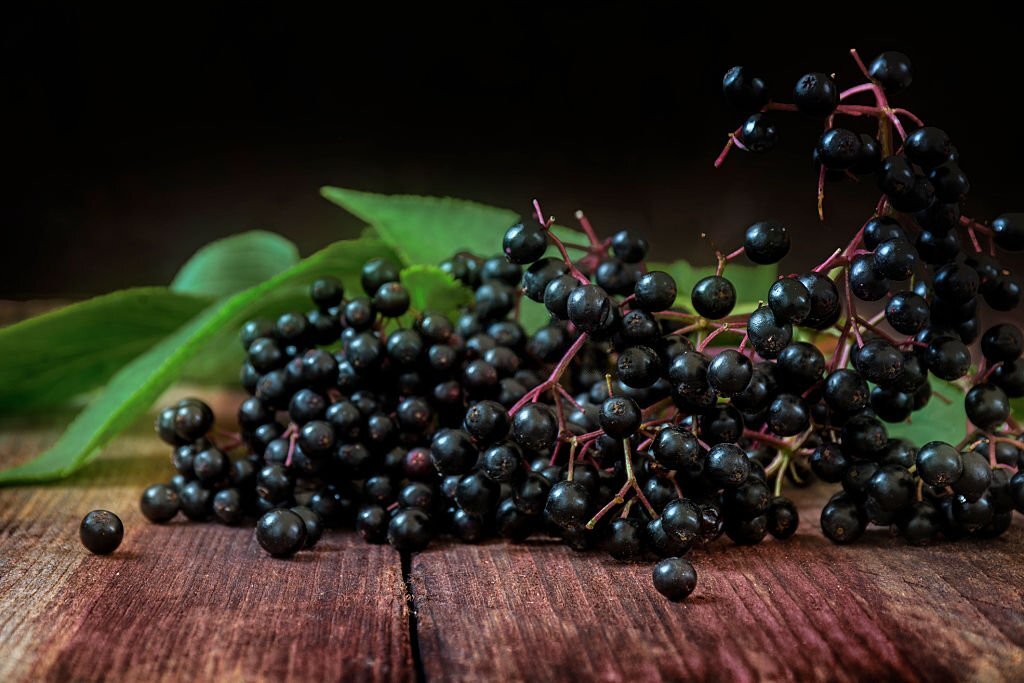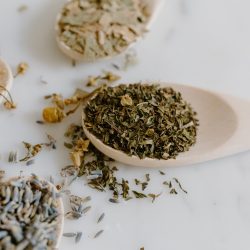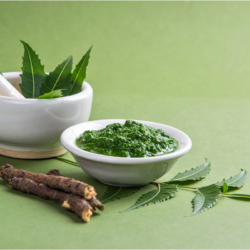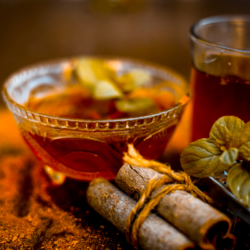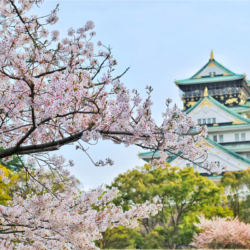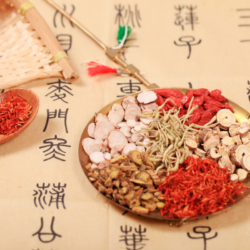Many vernacular names for elderberry refer to its slight acidity. This characteristic is often described by the adjective suret. Despite its acidity, elderberry has been appreciated since prehistoric times.Bronze and Iron Age sites bear witness to this. They have revealed deposits of elderberry seeds. We know that elderberries were already being harvested in Switzerland and northern Italy. The quantities harvested were perhaps sufficient to make a fermented drink. The little tree is typically European. Its history with man dates back at least 5,000 years.
What is the Elder tree?
Elderberry, scientifically known as Sambucus, is a genus of plants that includes several species, the best known of which is black elderberry(Sambucus nigra). This plant stands out for its versatility and its wealth of compounds that are beneficial to health.
Black elder is a shrub or small tree, generally reaching a height of 3 to 10 metres. It has a short trunk with grey-brown bark that becomes rough and cracked with age. The elder’s arching branches form a dense, rounded bush. Its compound, pinnate leaves grow up to 20 cm long. Each leaf is divided into 5 to 7 oval or lanceolate leaflets with slightly toothed margins. Their colour, dark green on top, becomes lighter underneath and they have a rough texture.
Elder flowers are small, white or cream-coloured and grouped in large, flat corymbs up to 20 cm across. They have a sweet fragrance and are very attractive to pollinating insects. They flower in late spring or early summer.
Elderberries are small, spherical berries, around 5-6 mm in diameter. When ripe, they are a deep purple-black colour and are grouped together in heavy clusters. The berries contain tiny seeds and are edible when cooked, although they are toxic when raw.
Black elder is a hardy and adaptable plant, able to grow in a variety of soils, although it prefers moist soils rich in organic matter. It is often found growing wild in woodlands, hedgerows and along watercourses.
Because of its medicinal properties and culinary uses, elderberry is a valuable plant in many cultures. Its flowers and berries are used to make infusions, syrups and other traditional remedies.
A little history
It may come as a surprise, but elderberries were known to the ancient Greeks, at least to Theophrastus, who gave them the nameaktê. By this time, some of its virtues had already been identified; the story goes that Hippocrates used the berries and leaves as a drastic treatment for dropsy, and the Hippocratics who followed him attributed identical properties to elderberry, making it a hydragogue, diuretic and laxative. It is therefore active, forcing this or that to circulate from point A to point B. That’s why, among other things, it doesn’t like ailments caused by sluggishness.
Dioscorides distinguishesaktê from chamaektê, otherwise known as ” earth elder “, which is none other than the beautiful hellebore(Sambucus ebulus), a plant that is closer to the earth in size than its “big” brother Sambucus nigra.
As a medicinal tree, elder appears in rituals, combining the medical with the magical. Albert the Great reported a belief in sympathetic magic. According to this belief, the bark acts as a laxative if removed from the trunk from top to bottom. It becomes vomitory if removed in the opposite direction. The importance of the gesture. And, as far as elderberries are concerned, it’s not so stupid, as this shrub can be both laxative and vomitory, purging at both ends, according to what some people have confessed!
Composition of Elderberry
The flowers and bark of black elderberry are rich in bioactive compounds that give this plant many of its therapeutic properties. Among these compounds are mucilages, viscous, moisturising substances known for their soothing effects on inflammation. Mucilages form a kind of protective barrier that can help calm irritated tissue, helping to reduce inflammation.
As well as mucilages, the flowers and bark of black elderberry also contain tannins. Tannins are polyphenols known for their astringent properties, which means they can help tighten and tone body tissues. This astringent quality can be particularly beneficial for mucous membranes, helping to reduce inflammation and soothe irritation.
Flavonoids, another group of compounds found in black elderberry, are well known for their powerful antioxidant properties. They help protect cells from damage caused by free radicals, helping to prevent many diseases and maintain overall good health.
Potassium nitrate, also present in black elderberry, plays a key role in the plant’s diuretic properties. It promotes the excretion of water by the kidneys, which can help reduce swelling and water retention, and support kidney function.
Finally, the phenolic acids in black elderberry also contribute to its diuretic action. These acids have a stimulating effect on the kidneys, helping to increase urine production and facilitate the elimination of toxins from the body.
What are the main pharmacological properties of Elderberries?
Elderberry, particularly black elderberry(Sambucus nigra), is renowned for its many pharmacological properties. Its flowers and berries are particularly valued for their therapeutic potential. Elderberries are rich in vitamin C and antioxidants such as anthocyanins, which boost the immune system and combat oxidative damage in the body. They also have antiviral properties, which are effective against certain viruses, particularly those that cause colds and flu. Elderflowers, appreciated for their anti-inflammatory and diuretic effects, relieve inflammation and help eliminate toxins. Elderberry is used for its expectorant properties, making it useful in the treatment of respiratory ailments. Use with caution, however, as some parts of the raw plant are toxic.
Antiviral and antibacterial properties
In 2006, research revealed that elderflower extract inhibits the release of pro-inflammatory cytokines by macrophages. These cytokines are induced by Porphyromonas gingivalis and Actonibacillus actinomycetemcomitans, two periodontal pathogens. The extract also suppresses the activation of neutrophils, which are involved in the destruction of periodontal tissue. These effects appear to be due to inhibition of activation of nuclear factor kappa B (NF-kB) and phosphatidylinositol 3-kinase (PI3K).
In 2011, an in vitro study demonstrated for the first time that standardised elderberry extract has antimicrobial activity against both Gram-positive bacteria (Streptococcus pyogenes and group C and G streptococci) and Gram-positive bacteria(Branhamella catarrhalis).
In vitro: Elderberry extract inhibits the H1N1 virus, responsible for influenza A, in a dose-dependent manner. This activity is more specifically linked to its flavonoid content, which binds to the H1N1 virus, preventing the virus from entering the host cell. The plant has been shown to be effective against 10 strains of influenza virus. Elderberries appear to act on two levels: firstly, they neutralise the activity of haemagglutinins, antigenic glycoproteins present on the surface of the virus and responsible for attaching the viral particle to a receptor located on the target cell. When these receptors are deactivated, the viruses can no longer enter the host cells and replicate. They also act by stimulating the immune system through increased production of cytokines by monocytes (IL-1β, TNF-α, IL-8, IL-10).
Anti-inflammatory and immunostimulant properties:
A study on 12 healthy donors revealed the effect of elderberry on inflammatory cytokines (IL-1β, TNF-α, IL-6, IL-8). These results were compared with lipopolysaccharide (LPS), a monocyte activator. The most notable increase was in TNF-alpha.
These immunostimulant properties could be useful for flu patients. They could also help immunosuppressed patients (cancer, AIDS) undergoing chemotherapy. Elderflowers traditionally have expectorant, diuretic and sudorific effects.
In people suffering from colitis, a diet enriched with elderberry extract has been shown to be beneficial. The diet halved macroscopic damage to the mucosa. It also reduced myeloperoxidase activity (a measure of neutrophil infiltration).
The study also observed an increase in lysosomal enzymes (acid phosphatase, cathepsin D). This indicates an improvement in the integrity of the colonic mucosa.
Antioxidant properties
According to the US Department of Agriculture, the anthocyanins in elderberries have one of the most powerful free-radical actions in the plant world, twice that of cranberries.
Of all fruits, elderberries contain the highest concentration of anthocyanins (5 times more than blueberries), including cyanidin-3-sambubioside-5-glucoside, which has been shown to have antioxidant activity.
Metabolic and vascular properties
Endothelial cell dysfunction plays an important role in the initiation and development of cardiovascular disease. In vitro, the incorporation of anthocyanins into these cells increases their protection against oxidative stress, a major cause of their dysfunction.
The traditional use of elderberry in diabetes has been backed up by evidence of its anti-diabetic properties. Elderberry extract also protects haemoglobin against glycation.
Are there any precautions to be taken when using Elderberry?
Although black elderberry has beneficial properties, it should be used with caution, given certain possible contraindications and interactions. The European Medicines Agency (EMA ) advises that elderberry should not be used by pregnant or breast-feeding women, or by children under the age of 12, due to potential risks that have not been clarified.
For diabetics, particularly those on insulin therapy, the use of elderberry requires close medical supervision. Imbalances in insulin treatment have been reported in these patients. Elderberry may interact with certain diuretic drugs. It may increase their theoretical activity.
If you are self-medicating, consult a doctor if you experience dyspnoea, fever or purulent sputum. Undercooked elderberries may cause heartburn, nausea or vomiting. Avoid raw berries, especially unripe ones. They contain sambunigrin, a toxic substance. There are interactions between elderberries and CYP3A4 inhibitors. The latter are involved in the metabolism of many drugs. This interaction is particularly notable with Echinacea purpurea.
The lectin in elderberry bark is toxic to the embryo in rats. This justifies caution during pregnancy and breast-feeding. It is therefore crucial to follow these precautions. Consult a health professional for safe use of black elderberry.
How to take Elderberry and at what dosage?
The forms and doses of black elderberry vary according to use. For dried flowers, the recommended dose is 3g per cup of boiling water, taken three times a day. This infusion can also be used as a gargle to soothe mouth and throat irritations. Black elderberry syrups are also frequently used to alleviate respiratory symptoms.
It is important to note that if a cough persists after a week’s treatment with black elderberry, it is imperative to consult a doctor. Similarly, a moderate fever lasting more than 48 hours in an adult should also lead to medical consultation. These precautions are essential to ensure that no more serious medical condition is overlooked.
- As a dietary supplement, in the form of dry extract in capsules, 2 to 4 capsules a day with a large glass of water.
- In the form of gummies or Swiss pasta: Dosage varies according to the product chosen.
- Standardised fresh plant fluid extract: 5 to 10 ml a day in a glass of water.
- Honey glycerine fluid extract: 5 to 15 ml per day in water.
- Elderberry syrup: One teaspoon 2 to 3 times a day.
- Mother macerate: Between 5 and 15 drops a day, depending on the person and the problem. Start with 5 drops and increase by one drop each day until a stable result is obtained.
What the health authorities think
Black elderberry is attracting interest for its traditional use and therapeutic potential. Current scientific evidence comes mainly from historical empirical data. However, recent clinical studies are beginning to assess its efficacy more rigorously.
These studies, although small in number and size, indicate that black elderberry juice may reduce flu symptoms. Although limited, they offer positive preliminary results on the effect of black elderberry.
As far as the health authorities are concerned, the use of black elderberry is widely recognised. The EMA (European Medicines Agency) validates the use of black elderflower for cold symptoms. This recognition supports traditional herbal medicine practices.
The WHO (World Health Organisation) is extending this use. According to the WHO, black elderflower helps combat fever, acts as an expectorant in minor bronchial infections and relieves cold symptoms.
The German Commission E, renowned for its expertise in herbal remedies, also confirms this use for relieving colds. This validation by a reputed health authority reinforces the credibility of the traditional use of black elderberry.
Medical literature and clinical trials
- Roschek B Jr, Fink RC, McMichael MD, Li D, Alberte RS. Elderberry flavonoids bind to and prevent H1N1 infection in vitro. Phytochemistry. 2009
- Youdim KA, Martin A, Joseph JA. Incorporation of the elderberry anthocyanins by endothelial cells increases protection against oxidative stress. Free Radic Biol Med 2000
- Ciocoiu M, Mirón A, Mares L, Tutunaru D, Pohaci C, Groza M, Badescu M. The effects of Sambucus nigra polyphenols on oxidative stress and metabolic disorders in experimental diabetes mellitus. J Physiol Biochem. 2009
- Krawitz C, Abu Mraheil M, Stein M, Imirzalioglu C, Domann E, Pleschka S, Hain T. Inhibitory activity of a standardized elderberry liquid extract against clinically-relevant human respiratory bacterial pathogens and influenza A and B viruses. BMC Complementary and Alternative Medicine 2011
- Pliszka B. Polyphenolic content, antiradical activity, stability and microbiological quality of elderberry (Sambucus nigra L.) extracts. Acta Sci Pol Technol Aliment. 2017
- Barak V, Halperin T, Kalickman I. The effect of Sambucol, a black elderberry-based, natural product, on the production of human cytokines: I. Inflammatory cytokines. Eur Cytokine Netw. 2001
- Barak V, Birkenfeld S, Halperin T, Kalickman I. The effect of herbal remedies on the production of human inflammatory and anti-inflammatory cytokines. Isr Med Assoc J. 2002

